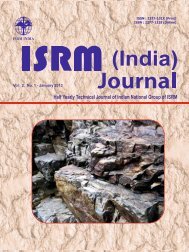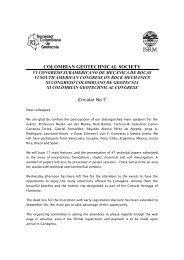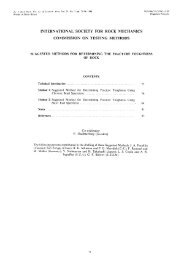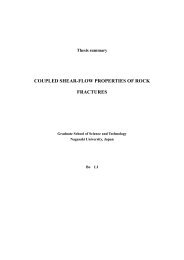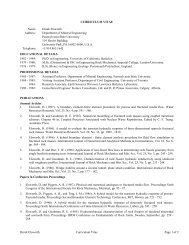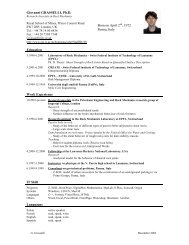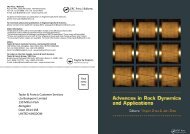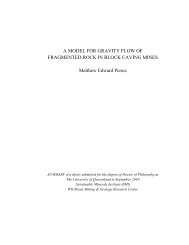ISSN - ISRM
ISSN - ISRM
ISSN - ISRM
Create successful ePaper yourself
Turn your PDF publications into a flip-book with our unique Google optimized e-Paper software.
Dynamic Properties of Sandstone Rock Subjected to Cyclic Loading11measurement of the velocity of propagation of ultra-soundwaves through rocks and associated materials. For mostapplications the following types of body waves are ofparticular interest (McDowell, 1993).(i) Compressional or longitudinal waves (P-waves).These have a particle motion in the direction ofwave propagation and travel faster than all otherwaveforms.(ii) Shear or transverse waves (S-waves). Groundmotion is transverse to the direction of wavemotion, i.e., polarized in one plane. In practice,the S-wave motion is normally polarized intocomponents which are parallel and perpendicularto the surface of the ground, i.e. S H- and S V-waves.The velocity of seismic waves depends upon a largenumber of factors, the most important being the elasticmoduli. For homogeneous isotropic elastic media, P- andS-wave velocities are related to dynamic elastic moduliand bulk density, using the following formulae:22.ρ .(1 + μd). Vs...(1)...(2)Ed= , ...(3)where,V pand V sare P- and S-wave velocities (m/s),E dis Young’s dynamic modulus of elasticity (N/m 2 ),ρ is bulk density (kg/m 3 ), andμ dPoisson’s dynamic ratio.Although most soil and rock masses are nothomogeneous and isotropic, they are usually consideredto behave elastically where stress levels are low, andwavelength is significantly greater than the dimensionsof pore spaces, voids and fractures. Therefore, whenderiving dynamic elastic parameters from seismic velocityvalues, it is very important to consider the relationshipbetween wavelength and the size, spacing, infill, etc., offractures. Although these formulae suggest that velocitywill decrease with increasing density, the opposite isnormally the case, because an increase in density isusually related to an increase in compaction and orcementation, resulting in an even more significantincrease in elastic moduli (McDowell, 1993).The average elastic dynamic properties of the rock testedin the laboratory, using seismic velocity measurements,are provided in Table 5. Altogether 37 rock specimenswere tested, representing all kinds of samples fromborehole Darkov 265-01. The wide variation in values ofelastic dynamic properties is due to variations inmineralogical composition, porosity and intra-structureamong different rock specimens and even in differentsamples coming from the same borehole. From Table 6it can be seen that changes in values from dry to saturatedcondition differ greatly, the percentage being as muchas 20% in the case of P-wave velocity and 29% in thecase of dynamic elastic modulus. According to Martinand Stimpson (1994), P-wave velocity is sensitive tocrack density, and hence, is a good indicator of sampledisturbance. The higher the sonic velocity is, the stifferthe rock. The difference in the values of sonic wavevelocity for dry and saturated conditions shows thepresence of micro-fissuring in the tested rock specimens.From this, it can be further concluded that the rockspecimens tested showed disturbances in terms ofmineralogy, coal intrusion, joints, cracks, etc.Table 5 : Dynamic properties obtained by seismic velocity measurement (parentheses show standard deviation)Sample Dry rocks Saturated rocks(Specimentested) V pd(m/s) V sd(m/s) μ ddρ dd(GPa) V ps(m/s) V ss(m/s) m dsE ds(GPa)D1 (2) 3256 (109) 2268 (38) 0.03 (0.03) 27 (2) 3875 (135) 2222 (40) 0.17 (0.01) 33 (1)D2 (2) 3438 (34) 2368 (30) 0.05 (0.01) 30 (1) 4138(50) 2316 (59) 0.22 (0.01) 39 (1)D3 (4) 4056 (233) 2638 (111) 0.13 (0.03) 40 (3) 4384 (322) 2564 (161) 0.19 (0.01) 45 (5)D4 (4) 3638 (145) 2396 (87) 0.11 (0.04) 32 (3) 4235(73) 2450 (33) 0.20 (0.01) 41 (2)D5 (5) 3679 (173) 2465 (92) 0.10 (0.03) 33 (3) 4285 (173) 2473 (94) 0.20 (0.01) 42 (4)D6 (5) 3666 (53) 2422 (60) 0.11 (0.03) 33 (1) 4187 (113) 2430 (94) 0.20 (0.04) 40 (2)D7 (5) 4439 (180) 2864 (167) 0.14 (0.06) 47 (4) 4775 (207) 2752 (109) 0.20 (0.01) 52 (4)D8 (5) 3740 (654) 2673 (120) 0.15 (0.03) 41 (5) 4304 (609) 2666 (156) 0.21 (0.01) 49 (6)D9 (5) 3965 (269) 2588 (98) 0.13 (0.04) 38 (4) 4396 (263) 2527 (126) 0.20 (0.02) 44 (6)Volume 1 v No. 1 v January 2012






